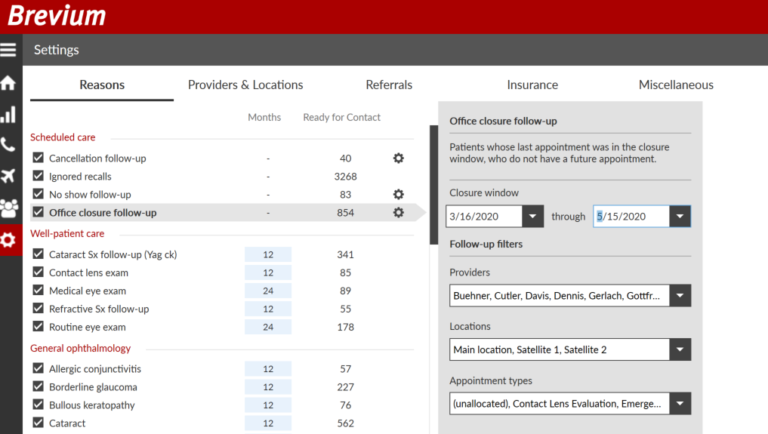The Brevium Blog

The Art of Patient Retention: How Patient Reactivation Software Can Redefine Healthcare
If healthcare providers can agree on anything, it’s that patient retention is vital for the health and success of both their business and their patients. Patient retention rate isn’t just a measurement determining how many established patients return to your practice for treatment—it’s also a way to determine a practice’s level of engagement with its patients. With the cost of acquiring a new patient amounting to five times more than retaining an existing one, the importance of patient retention in healthcare can’t be understated.
Successful healthcare professionals understand the value of effective patient retention strategies and are always seeking ways to improve their retention rate and quality of care. Perhaps the biggest factor in improving your patient retention rate is the evolution of patient engagement technology that allows practices to gather and store valuable patient information, streamline workflows, enhance the patient experience, and ultimately, boost the organization’s bottom line. This area is where Brevium shines. Brevium’s patented patient reactivation software integrates with practice management systems to mine for lost or overdue patients and perform strategic outreach to bring them back for treatment. Keep reading to learn why patient retention and patient reactivation go hand-in-hand and how modern engagement technology can help organizations overcome retention challenges.
UNDERSTANDING PATIENT RETENTION AND REACTIVATION
Despite being two different concepts, patient retention and patient reactivation share a common goal within organizational workflow: patient engagement. Where patient retention is often aimed at engaging current customers to keep them coming back for treatment, patient reactivation engages your customers that have slipped through the cracks and are overdue for essential treatment. Any healthcare professional can tell you that losing patients is costly; in fact, practices lose over $200 on average per missed appointment. Considering the treatment lifecycle of some patients, failing to engage your patients could cost your practice over thousands of dollars per provider every year.
What is Patient Retention?
Patient retention refers to a healthcare organization’s ability to engage its patients to keep them coming back for future appointments. Patient retention strategies are often aimed at established customers to maintain a growing patient base. With the odds of selling to an existing customer between 60 and 70 percent compared to a new customer at five to 20 percent, repeat business is vital to your organization’s long-term success.
What is Patient Reactivation?
Patient reactivation is the process of identifying lost or overdue patients and using strategic outreach to bring them back for treatment. While there is no way to “retain” patients you have already lost, this does not mean they should remain inactive. Your inactive patients are still your patients regardless of how recent they have treated with you; after all, employing customer reactivation strategies to bring them back for treatment is the best way to turn an inactive patient back into a loyal, repeat customer.
CHALLENGES IN PATIENT RETENTION
Most healthcare professionals have a solid grasp on how patient retention impacts their organizations’ reputation and success. While some patient attrition is inevitable, many patients leave because they aren’t satisfied with their experience or service. Patient retention is all about creating meaningful experiences for your patients and the success of your engagement efforts can significantly influence whether your patient returns for more treatment. The following are common challenges organizations face with patient retention and how to address them:
1) Communication issues with current patients.
Under-communicating with your patients is one of the most critical mistakes you can make when it comes to patient retention in healthcare. Many patients often have questions and concerns about their conditions and may need additional guidance on maintenance between appointments or preparation for an upcoming visit. Other patients might need reminders of their upcoming appointments and failure to engage them can lead to increased no-shows and last-minute cancellations. This failure to communicate widens the gap between providers and patients; in fact, studies show that up to 31.5 percent of patients who miss appointments do so because of lack of communication.
One of the best ways to combat communication issues would be implementing a patient engagement software that mends the patient-provider gap by automating the patient outreach process. This type of software has many benefits: personalized messaging for authenticity; timely notifications; automated outreach through a variety of methods; and more. Allowing patient engagement software to do the heavy lifting allows your staff to focus efforts on the highest priority tasks with the assurance that your patients’ needs are being met.
2) Long wait times.
In a consumer-driven society where patients have the choice to “shop” for their healthcare providers, customers no longer pick their providers based on care quality alone. A 2019 NRC Health study found that out of more than 223,000 healthcare consumers surveyed, 51 percent considered convenience and access to care to be the most important factors in choosing a provider. Shockingly, convenience surpassed insurance coverage (46 percent), staff conduct (44 percent), brand reputation (40 percent), and quality of care (35 percent).
Long wait times is one of the biggest factors in a decreasing patient retention rate. In almost all cases, patient satisfaction decreases with longer wait times. Here’s where technology comes into play. With the right software, your practice can send automated reminders, offer self-scheduling tools and utilize pre-appointment check-in forms so your patients can arrive at their appointments ready to go. Not only does software enhance the patient experience, but it also eases staff burdens and helps maintain a steady workflow. With 63 percent of patients saying they’d find a new provider if they consistently waited too long for appointments, investing in a software solution to assist with scheduling and reminders becomes essential for improving patient retention.
3) Ineffective appointment reminders.
Most organizations implement appointment reminders into their workflows, though the process may look different from between practices. Effective appointment reminders are critical for patient retention—failure to do so will not only lead to increased no-shows, but increased frustration for providers and patients alike. It’s easy to blame the patient for failing to show up, but it’s more likely a sign that your appointment reminder strategy isn’t working properly.
Consider how your practice sends appointment reminders. Does your staff manually call each patient days before the appointment? Do you manually send emails or does a software do it for you? While any appointment reminder is better than no reminder, using a software to automate the outreach process is much easier for your staff. Implementing a software also reduces room for human error by ensuring patients receive their reminders in a timely manner through their preferred communication channels. While you can’t always avoid emergencies and one-offs, implementing a more effective reminder strategy can boost your patient retention rate and help keep patients loyal and satisfied.
4) Patient satisfaction matters.
Patient satisfaction is all about meeting your patients’ expectations of what should happen during their visits. While providing the highest quality medical care is still of the utmost importance, your patients will have multiple interactions and impressions before they even reach the exam room. Switching the label from patient to consumer will help shift the mindset that patients shop for their providers like they would a new pair of shoes and improving on the patient experience only leads to increased satisfaction.
One of the best ways to improve patient satisfaction is sending post-visit surveys asking for feedback and taking the comments into consideration. Regardless of whether the comments are positive or negative, the feedback provided will help you know where to improve and address the possible issues. Addressing these concerns on a personal level could also help your practice avoid negative online reviews by patients who just want to be heard. More ways to improve patient satisfaction include kind interactions, self-scheduling and advanced check-in options to reduce wait times, personalized outreach on birthdays or special occasions, and more. As you begin to focus more on patient satisfaction, the result will be increased loyalty, improved health outcomes and greater compliance with their treatment schedules.
5) Complex appointment scheduling.
In the past few decades, technology has advanced to the point where anyone with a smartphone has the power to watch movies or shows, play games, pay bills, and much more with just a few clicks and swipes. They can also self-schedule appointments from these mobile devices and according to a 2021 study, people want the convenience to schedule medical appointments online more than any other service. Likewise, 94 percent of survey respondents said they would switch providers if they offered online scheduling options. If you’re still making your patients call to schedule appointments, you might not only lose interested new customers but also your established patients to competition who offers these services.
However, organizations can overcome this challenge by offering online appointment scheduling alongside phone booking. Many patients—up to one-third—still prefer manual appointment scheduling, but that number is trending down as more people begin to adopt tech-savvy lifestyles. With appointment scheduling options that are both quick and accessible, your organization will see a boost in its patient retention rate.
THE ROLE OF TECHNOLOGY IN PATIENT RETENTION
There are many options for healthcare organizations to consider when looking to improve their patient retention rate. But with modern technology usage quickly becoming an integral part of daily life, the most logical approach involves implementing patient engagement technology that would help bridge the gap between patient and provider and enhance the overall care experience. In a competitive industry where patients have more power than ever to be picky about their care providers, utilizing modern software to perform automated outreach and streamline the appointment process allows your patients more flexibility and might help you edge out the competition.
As we’ve established, patient reactivation plays a vital role in patient retention; after all, the right customer reactivation strategies could turn an inactive patient back into a loyal customer. These overdue patients are still established patients in that they’ve already treated with you. Why wouldn’t you try to bring them back and retain them? Sadly, the patient reactivation process can be tricky and time-consuming when done manually and most practices lack the time to reactivate efficiently. Luckily, there is software like Brevium available that streamlines the reactivation process, requiring less time from your staff while achieving more desirable outcomes.
BREVIUM’S PATIENT RETENTION AND REACTIVATION SOLUTIONS
There are typically hundreds to thousands of overdue patients per provider not receiving essential medical care. These patients combined amount to about 25 percent of a practice’s total clientele. The reasons may vary of why these patients went inactive; regardless, Brevium’s specialty is identifying these lost patients and employing data-backed engagement solutions to bring them back for treatment. The following are key features of Brevium’s patented software and how its customized solutions will take your reactivation campaign and patient retention efforts to the next level:
Þ Automated Outreach Using Varied Contact Methods:
Brevium employs various outreach methods to ensure maximum patient reachability. Offering a choice between automated methods such as autocalls, texts, emails, postcards, and letters versus live staff calls, practices have full control over their customer reactivation campaign. Brevium’s 2019 ALOHA study found that making more than four contact attempts using more than one contact method can boost patient reactivation rates by 81 percent. Further, Brevium’s system operates in the background, meaning you don’t need to login to the database for the software to contact patients. Brevium’s automated outreach features coupled with its proven reactivation strategy makes the software a stress-free investment that allows each practice to create a custom fit solution.
Þ Customized Solutions:
Brevium’s patented data mining tools enables you to pick and choose which patients to reactivate based on your practice goals. The mining capabilities allow practices to not only find patients based on their last treatment date, but also uses detailed patient qualifiers such as diagnosis and procedure codes, providers, locations, insurances, and referrals. This tool is especially useful when trying to fill a provider’s schedule with patients who’ve received a specific diagnosis.
Þ Advanced Reporting:
Brevium’s advanced reporting tools allow practices to monitor the success of their patient reactivation efforts down to the very detail. Many practices have raw data that is difficult to translate into actionable insights without the right tools, often leaving them to work toward growth in the dark. With Brevium, you no longer need to “pay and pray” that the technology delivers on its promises—you know exactly what you’re getting out of the software. With over 20 different detailed reports readily accessible on Brevium’s interactive dashboard, here are a few examples of reports that would help your practice make data-backed decisions on how to improve patient retention and provide higher quality care to patients:
– Tracks every aspect of patient encounters—contacts made, appointments scheduled, appointments kept, and more.
– Advanced ROI tracking and reporting down to the penny.
– Number of procedures done on reactivated patients.
– Track insurances to see which companies pay the most and least.
Þ BreviumStitch:
Perhaps the biggest reason organizations lose patients is switching practice management systems. Manual data migration takes an incredible amount of time, effort and money from your staff and because of this, many practices forgo complete data transfer. As a result, organizations are left with patient names and demographics with no attached treatment history.
However, Brevium offers an inexpensive solution to this problem with the BreviumStitch. Simply put, Brevium can link your old management system to your new database to produce one seamless file of patient history. The software accomplishes this task by comparing data from the old and new databases and uses the information to match patients with providers and locations across the two systems. Why is this information necessary for patient reactivation? While not impossible, patient reactivation is extremely difficult without a full patient profile and often results in lost staff time, patients and revenue. The BreviumStitch is invaluable for restoring the full treatment history that is needed to reactivate lost patients and improve patient retention rates.
CASE STUDIES AND SUCCESS STORIES
Brevium currently has hundreds of customers and thousands of providers using the patented reactivation software to enhance patient care, increase patient compliance and access untapped revenue streams in overdue patients. From single-provider practices with one location to multi-provider practices with multiple locations, Brevium’s impact is felt throughout. Below are a few of many success stories of why healthcare professionals love Brevium:
Bellaire Eye Care Center (BECC): BECC is a two-provider ophthalmology practice based in Houston, Texas that boasts a stellar reputation of delivering the highest quality and most advanced care. BECC joined Brevium in January 2021 after hearing of the software’s unique ability to identify inactive patients and bring them back for treatment. One aspect of Brevium loved by provider Rosa Tang, MD, MPH, MBA was the ability to reactivate patients for her clinical trials. The ability to identify and contact inactive patients using ICD-10 and CPT codes meant she could quickly and easily find and reactivate patients that would be interested in further treatment. As of July 2023, these were BECC’s results:
Þ 1,226 patients reactivated.
Þ 54.5 x ROI (for every dollar paid to Brevium, BECC received $54.50 in return).
Þ Dr. Tang conducted trials for thyroid eye disease patients. She estimates 90 percent of her trial subjects were found by Brevium.
Covenant Physician Partners & Texas Eye Care Network (TECN): Covenant Physician Partners is a renowned physician services organization known for its strategic collaborations with top practices in GI and ophthalmology. In the case study, we highlight Covenant and TECN’s success with Brevium’s patented patient reactivation software in mending the gaps created by provider turnover and patients inactivity. Specifically, the study details how the reactivation journey typically began with critical office visits that often progressed to ASC. Here are the results:
Þ 1,163 overdue patients reactivated by utilizing personalized texts and live calls to patients needing crucial exams.
Þ 22 percent return rate of contact patients to the practice.
Þ $968,638.54 collected from office visits and additional $490,544.55 in ASC revenue.
Þ 361 of reactivated patients went on to receive cataract surgery.
Carolina Allergy and Asthma (CAAC): CAAC is a 14-location organization that specializes in treating patients with asthma, allergy and immunology conditions in Charlotte, North Carolina and the surrounding areas. After only a year of implementing Brevium to reactivate patients who no-showed, cancelled or simply forgot to schedule another appointment, CAAC saw impressive results:
Þ 5,500 overdue patients reactivated.
Þ 37x ROI on office visits alone (for every dollar paid to Brevium, CAAC received $37 in return).
Þ Used combination of texts, emails and autocalls to achieve results.
Þ 42 percent of patients who scheduled an appointment responded to the autocall.
Patient retention is the key to maintaining and growing a successful medical practice or organization. Your patient retention strategies not only help you drive revenue and fuel practice growth, but also help you form meaningful relationships that will turn one-off patients into loyal customers. Part of your patient retention efforts should include patient reactivation or in other words, converting your inactive established patients back into repeat customers. While manual reactivation is possible, automating the process with a software will save your practice time and energy while seeing a greater return on investment. Contact us today to learn how Brevium can take your efforts to the next level.














